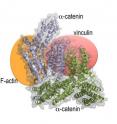New study defines the long-sought structure of a protein necessary for cell-cell interaction
Related images
(click to enlarge)
Scientists know that cells in all higher organisms need to bind to each other for the development, architecture, maintenance and function of tissues. Mysteries have remained, however, about exactly how cells manage this feat. Scientists from the Florida campus of The Scripps Research Institute (TSRI) have now solved part of this puzzle by defining the structure of a protein known as α-catenin, which is essential to this process.
The work was published online ahead of print on January 6, 2012, by the journal Nature Structural & Molecular Biology.
Chain, Chain, Chain
Our cells bind to each other using specialized cell surface adhesion complexes called adherens junctions, which direct the formation of tight, Velcro-like contacts among cells.
Adherens junctions are made up of three types of proteins -- cadherin, α-catenin and β-catenin. First, cadherin receptors, which span the cell membrane, direct the binding of cells to each other using domains that project outside the cell. Second, their tail domains, found on the inside of the cell, bind to the protein β-catenin, which, in turn, is bound to α-catenin.
The term catenin is derived from the Latin word for chain, catena, and these three proteins literally make a chain. This complex is then stabilized when the end of the chain, α-catenin, attaches to the molecular framework of the cell, the cytoskeleton. Without this, link cells would simply be amorphous piles of goo. Furthermore, alterations of cadherins, β-catenin and/or α-catenin can lead to marked changes in cell signaling, growth and migration -- which can result in abnormalities and cancer.
Confronting a Paradox
Exactly how α-catenin provides links to the cytoskeleton and to the cadherin-β-catenin complex, however, has long puzzled scientists.
Scientists have known that α-catenin forms links to the cytoskeleton by binding to a protein called F-actin (the "F" stands for filament), which is found in species ranging from yeast to humans. The paradox for scientists has been that, despite being able to bind to F-actin on its own, when bound to α-catenin α-catenin cannot bind to F-actin. That is, the binding of α-catenin to F-actin and to β-catenin are, in the test tube, mutually exclusive. So how does α-catenin bind to F-actin versus β-catenin and how is the final link in the chain stabilized in cells?
To resolve this paradox, the scientists crystallized and determined the structure of a nearly full-length human α-catenin. This structure showed why α-catenin cannot simultaneously bind to F-actin and β-catenin. Specifically, in its unbound state, α-catenin was shown to be an asymmetric dimer, where the two subunits have remarkable differences in their architecture that appear to together create the binding site for F-actin. Binding of β-catenin to α-catenin disrupts the interaction of its two subunits, changing its architecture and displacing F-actin.
The second part of the puzzle -- how cadherin-β-catenin and α-catenin-F-actin complexes are linked together in cells -- was resolved when the scientists realized that another cytoskeleton protein called vinculin, which can also bind to F-actin, plays a critical role in this process. The scientists established the structures of dimeric α-catenin alone and when in complex with pre-activated vinculin. The results showed that vinculin binding did not disrupt the α-catenin dimer and that both partners of the vinculin-α-catenin complex were in fact capable of binding to F-actin, a scenario that stabilizes adhesion complexes.
The study, "Dimer Asymmetry Defines α-catenin Interactions" (doi 10.1038/nsmb.2479) was authored by Staff Scientist Erumbi S. Rangarajan and Associate Professor T. Izard of TSRI.
The laboratory is supported by the National Institute of General Medical Sciences of the National Institutes of Health (GM071596 and GM094483) and by the State of Florida.
Source: The Scripps Research Institute
Other sources
- Long-sought structure of protein necessary for cell-to-cell interaction describedfrom Science DailySun, 6 Jan 2013, 20:30:22 UTC
- New study defines the long-sought structure of a protein necessary for cell-cell interactionfrom PhysorgSun, 6 Jan 2013, 18:00:49 UTC
